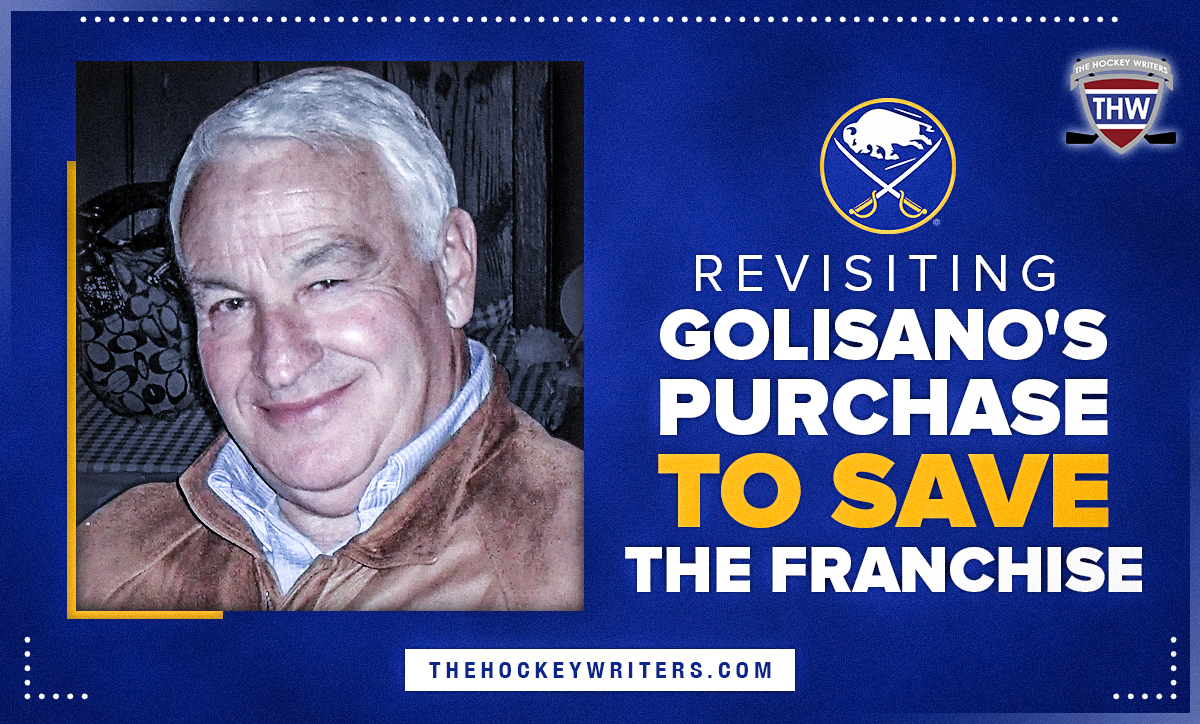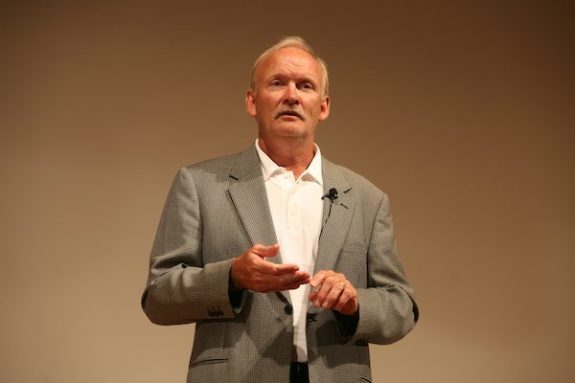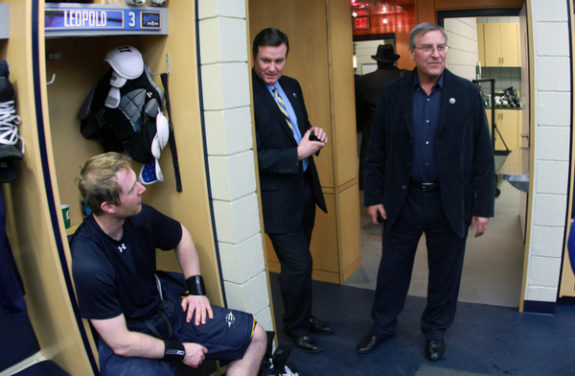With how firmly entrenched they’ve become in the city, it’s hard to imagine Buffalo, NY without the Buffalo Sabres. But it’s sometimes forgotten in hindsight that was nearly the case at one point.
The early 2000s were the darkest times in Sabres history, beginning when owner John Rigas was stripped of the team by the NHL after he was indicted on fraud charges in 2002. The Sabres spent a year staring almost certain relocation in the face and fans had to brace themselves for it. That is until a savior stepped forward.
Rochester, NY native Tom Golisano rescued the franchise in March 2003, preventing Western New York from suffering what surely would have been a devastating economic and cultural blow. This month marks the 20th anniversary of the occasion, and though Golisano’s name may not exist much in the consciousness of Buffalonians anymore, his actions should never be forgotten.
Rigas Booms And Busts
When Adelphia Communications CEO and Wellsville, NY native John J. Rigas purchased the Sabres in December 1997, it was a dream come true for fans. After co-founder Seymour Knox III passed away in May 1996 and his brother Northrup became sole owner, the team began to experience increasingly severe financial hardships, and though the product on the ice didn’t decline, the Sabres organization buckled and almost missed payroll the same month Rigas took over.
As the owner of one of the largest cable television conglomerates in the United States at the time, the mogul was welcomed as a hero in Buffalo and soon became revered for his generosity and philanthropy. In addition to rescuing the Sabres from potential bankruptcy, Rigas and Adelphia brought numerous jobs to the region and helped revitalize its stumbling economy through numerous charitable acts (from “John Rigas, disgraced cable tycoon, former Sabres owner, dies at 96”, The Buffalo News, 9/30/2021).
And with his innumerable assets backing them, the Sabres were re-energized and went to the Stanley Cup Final in his first full season as owner. Though they were defeated, the franchise’s newfound vibrancy was evident and it seemed that there was nowhere to go except up. But as we all know by now, that wasn’t the case.
Two seasons removed from their greatest success to date, the Sabres suddenly began experiencing financial hardships again, and the reason was soon revealed. In the summer of 2002, the United States government indicted Rigas and four other Adelphia executives on numerous fraud charges, including over $2 billion in unreported losses. He was found guilty in 2005 and was sentenced to 15 years in prison.
Uncertainty Looms In Buffalo
In the wake of the scandal, the NHL stripped Rigas of virtually all his authority over the team and the Sabres became a ward of the league, though he technically remained the owner on paper. The next year was spent searching for a potential buyer, but for what seemed like an eternity, none came forward. Rumors circulated in August 2002 of a potential bid led by Canadian businessman Sherwood Bassin, then-owner of the Ontario Hockey League’s Erie Otters, but they failed to materialize (from “Group Preparing Offer To Buy Sabres”, The Buffalo News, 8/9/2002).
Then, a glimmer of hope came in November when Mark Hamister, chairman of the Buffalo-based Hamister Group, submitted a proposal. It was accepted by the NHL and for a moment, it seemed that Sabres fans could breathe easy once again. But their hopes were dashed when Hamister’s investing partner Todd Berman of Chartwell Investments suddenly withdrew from the agreement before it could be finalized. Hamister could not move forward without Berman’s involvement and eventually had no choice but to withdraw his bid. The Sabres filed for Chapter 11 Bankruptcy not long after.
Related: 7 Cool Things About the Buffalo Sabres French Connection
After the failed Hamister bid, Sabres fans and the Western New York community alike had to face the reality that the team’s time may have been running out. NHL commissioner Gary Bettman reaffirmed his desire to sell to a buyer who would keep it in Buffalo, but with nothing on the horizon, relocation became increasingly realistic.
Losing the team would have spelt disaster for the region’s economy that not five years earlier Rigas had jump-started and pundits braced for a considerable loss of jobs (from “Losing Sabres Would Be A Serious Blow To The City”, The Buffalo News, 1/8/2003). And with the Sabres gone, then-HSBC Arena would have become vacant and likely would have been repurposed or perhaps just demolished altogether. A true lose-lose scenario seemed inevitable.
Golisano To The Rescue
Hamister seemed to be the last chance for the Sabres and after his bid failed, the city resigned itself to the fact that the team was likely headed elsewhere or perhaps even folding outright. But just when it seemed that all hope had been lost, a savior emerged from the ranks.

In January 2003, The Buffalo News reported that B. Thomas Golisano, founder and CEO of Paychex, Inc, had submitted a bid to the NHL (from “Golisano Submit New Offer For Sabres”, The Buffalo News, 1/24/2003). Buffalo real estate mogul Louis Ciminelli had encouraged the Rochester, NY native to purchase the team the previous Fall, but the NHL rejected his offer in favor of Hamister’s. But when Hamister stalled, another opportunity presented itself. This time, Golisano had the advantage as his offer included no government funding, something Hamister was forced to seek after Berman abandoned him. But after so many disappointments over the previous months, fans and media alike were sceptical.
However, this time proved to be the real deal. In February the NHL verbally agreed to the sale and it was finalized in March for a purported $15 million (from “NHL; Golisano Group To Buy Sabres”, The New York Times, 3/14/2003). On March 19, 2003, the NHL officially introduced Golisano as the new owner of the Sabres, finally bringing a near-12 month period of tension and suspense to an end.
A New Beginning For The Sabres
Golisano succeeded in his mission of securing the Sabres’ place in Western New York, but his work as the owner was cut out for him still afterwards. The franchise had been saved, but the product on the ice and the fanbase needed saving as well. One of his first official acts was changing the team’s ticket pricing system to make non-marquee games more affordable. And it worked, as the number of season ticket holders eventually spiked to more than 15,000 as a result.
But though more fans were coming to games, the team they were coming to watch was less than ideal. The drama of the ownership saga largely took the spotlight away from the Sabres themselves, but they too had a rough go of it. If their regression had started during the previous season, the 2002-03 campaign was rock bottom, as they finished with a 27-37-10 record and 72 points, their worst since 1986-87.
Since the team was under the control of the league for the majority of the season, general manager Darcy Regier and head coach Lindy Ruff couldn’t do anything except sit on their hands. But when the new ownership at last took over, they immediately began a dramatic rebuild and cleared out the last remaining vestiges of its late 90s glory days, including captain Stu Barnes and longtime fan favorite enforcer Rob Ray. It signaled both the end of an era and the dawn of a new one for the team.

At the 2003 NHL Draft Golisano pledged that the organization would turn itself around, and though it took a while, his words rang true. Thanks to an influx of strong young talent and a number of excellent trades by Regier, the Sabres experienced a 13-point improvement in the 2003-04 season and narrowly missed a playoff spot. After the 2004-05 Lockout cancelled the entire season, the team made it to the Eastern Conference Final in consecutive years in 2006 and 2007.
Golisano Brought Stability To Sabres
Golisano quickly brought winning back to Buffalo after the most tumultuous period in Sabres history, but his greatest achievement was the balance and security he gave to the organization. After the struggles at the end of the Knox Era, Rigas promised to steady the Sabres, and though he did in the short term, he ended up leaving them in drastically worse shape than when he started.
His successor would be tasked with not just keeping the team in Buffalo, but also providing sustained security to a franchise that had long since lacked it. Throughout the Rigas era, the Sabres reported yearly eight-figure losses on multiple occasions that he had attempted to remedy with the funds he embezzled from Adelphia. Golisano flipped the script and the organization brought in yearly profits ranging from $5 million to $12 million in his eight years as owner (from “‘Tom saved hockey in Buffalo’: How the Golisano years rescued the Sabres”, The Buffalo News, 9/13/2019).

The rejuvenation of the franchise did not go unnoticed by the sports world. In April 2007 ESPN the Magazine ranked them first of 122 professional sports franchises in North America, owing to their culture, affordability and success on the ice. It was a dramatic change of perception for a team that just four years earlier had declared bankruptcy. It also showed that the new ownership’s goals had been reached.
Still, Golisano received criticism during his tenure. He was known as a very hands-off owner, never making a coaching or front-office firing, and was at times accused of not financially investing in the team. The departure of numerous key players to free agency, most notably Chris Drury and Daniel Briere was often attributed to this. But whether one believes that or not, it’s impossible to deny that he turned the franchise into a stable, profitable entity after years of it being the exact opposite.
A Lasting Legacy: Golisano Saved The Sabres More Than Once
In November 2010 it was reported that natural gas tycoon Terrence M. Pegula, founder and CEO of East Resources, had stated his intentions to purchase the Sabres. He and Golisano eventually agreed to a price of $189 million and in February 2011, another new era in Sabres history began, but not before one last act of dedication to Buffalo from Golisano was revealed.
In 2008, he received an offer from Jim Balsillie, CEO of Canadian tech company Research In Motion which was reportedly for $70 million more than the price he agreed to with Pegula in 2011. However, he immediately rejected the offer when Balsillie indicated his intentions to relocate the franchise to nearby Hamilton, ON.

On Feb. 23, 2011, Pegula was officially introduced as owner before the Sabres’ matchup with the Atlanta Thrashers and he has been at the helm ever since. The team and arena (since renamed First Niagara Center and now KeyBank Center) have grown considerably under Pegula, but none of that would have been possible had Golisano not paved the way.
The former owner has faded into the background in the years since, partly owing to the negative attention Pegula has garnered at times, but his contributions to the Sabres and Western New York as a whole should never be forgotten even 20 years later. In the eight years of his ownership, the team emerged from the direst of straights and became one of the most profitable entities in the NHL, even though the team never won a championship in that span.
Some argue that Golisano didn’t do enough for the team, but the fact remains that, if it hadn’t been for him, there is a very strong chance that the Buffalo Sabres might not even be the Buffalo Sabres anymore. For that, every fan of the team both past and present should count their blessings.